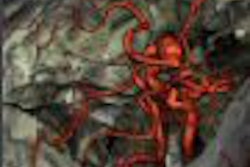Patients who learn they have coronary artery disease (CAD) might be wise to get more screening. A new study links the presence of coronary artery disease at angiography to a high likelihood of colorectal polyps and cancer at colonoscopy.
The study, appearing in the September 26 Journal of the American Medical Association, revealed more new information about individual risk factors than about the general association between heart and colon disease, the authors noted.
Colorectal cancer and CAD are known to share environmental factors "such as diabetes mellitus; smoking; hyperlipidemia; sedentary lifestyle; high-fat, low-fiber diet; obesity; and hypertension," wrote Dr. Annie On On Chan and colleagues from the University of Hong Kong, Ruttonjee Hospital, and Tuen Mun Hospital, all located in Hong Kong, as well as the M. D. Anderson Cancer Center in Houston. "The metabolic syndrome is being increasingly recognized as a significant health issue worldwide. It comprises a constellation of metabolic risk factors including most of the underlying risk factors for colorectal cancer and CAD" (JAMA, September 26, 2007, Vol. 298:12 pp. 1412-1419).
Colorectal cancer is the second most common cancer worldwide; an estimated one in 20 healthy individuals eventually develops the disease. For its part, coronary artery disease is the leading cause of death in the U.S. and other industrialized countries.
The authors explained that they had observed an association between colorectal cancer and coronary artery disease in an earlier study, but were unable "to identify the risk factors involved because of its retrospective nature."
"We thus designed and conducted the current cross-sectional study, the primary aim of which was to investigate the prevalence of colorectal cancer and adenoma (colorectal neoplasms) in patients with newly diagnosed CAD," they wrote. A secondary goal of the prospective study was to identify the underlying risk factors, after adjusting for age and sex, that predisposed patients to the two conditions.
The results have important implications for colon cancer and CAD, as well as for colorectal cancer screening strategies, they wrote.
The study examined consecutive patients in Hong Kong who were recruited for colonoscopy screening after undergoing conventional coronary angiography for suspected CAD (i.e., those with angina, or abnormal stress or exercise test results) from November 2004 to June 2006.
The patients were divided into three groups, including 206 patients with CAD (defined as at least 50% luminal narrowing in any one of the major coronary arteries) and another 208 who were considered CAD-negative.
Because age and sex matching were not available in the CAD-negative group, a third group consisting of 207 healthy participants from the general population served as a control group that was matched by age and sex to the CAD-positive group, the authors wrote. These subjects did all have functional epigastric pain, but a normal result on upper endoscopy exams performed in the facility.
Chan and her colleagues collected information from all participants on age, sex, smoking history, hypertension, family history of colorectal cancer, and use of aspirin and statins. Patients presenting for coronary angiography for reasons other than suspected CAD were excluded, as were those who had been taking aspirin or statins for more than a year. Subjects with a history of colonoscopy, colonic disease, or colorectal surgery were also excluded.
Waist circumference was measured and blood was drawn to measure complete lipid profiles. Conventional colonoscopy was performed within eight weeks of assessing participants' eligibility.
The results showed significantly more colorectal lesions, advanced lesions, and colorectal cancers in patients with at least one significant coronary artery stenosis at angiography.
"The prevalence of colorectal neoplasm in the CAD-positive, CAD-negative, and general population groups was 34.0%, 18.8%, and 20.8% (p < 0.001 by x² test), prevalence of advanced lesions was 18.4%, 8.7%, and 5.8% (p < 0.001), and prevalence of cancer was 4.4%, 0.5%, and 1.4% (p = 0.02), respectively," the authors wrote.
Fifty-five percent (5/9) of the colorectal cancers detected in the CAD-positive group were at an early stage (Dukes A or B), and were smaller than 3 mm in diameter. "Only one cancer (0.5%) and three cancers (1.4%) were detected in the CAD-negative and general population groups, respectively," the authors wrote. Eight of the nine cancer cases were asymptomatic. One patient developed colonic perforation during polypectomy for a 2-cm sessile villous adenoma and recovered after surgery; no other complications were seen.
The mean age and distribution of family history were "insignificantly different among the three groups, but there were differences in the distributions of sex, smoking history, metabolic syndrome (as set forth by the National Cholesterol Education Program), and the individual factors of the metabolic syndrome among the three groups," they wrote.
Metabolic syndrome and history of smoking were both strong independent predictive factors for the positive association between advanced lesions and CAD.
For CAD-positive, CAD-negative, and general population participants, the distribution of subjects having ever smoked was 37.9%, 17.8%, and 21.7%, respectively (p < 0.001); distribution of metabolic syndrome was 37.9%, 18.3%, and 9.7%, respectively (p < 0.001); and the distribution of male gender was 78.2%, 63.5%, and 73.4% in the three groups, respectively.
"The final model indicated that the association between CAD and colorectal neoplasm did not depend on any of the aforementioned explanatory variables," Chan and colleagues wrote, adding that it would be ideal to perform an age- and sex-matched study in both CAD-positive and CAD-negative populations.
"The high prevalence (18.8%) of advanced lesions in CAD-positive patients in the study is remarkable," the authors stated. "This is much higher than the 12.5% reported in the general population in Hong Kong by Sung et al, and the 10.5% in the U.S. general population."
"Both colorectal neoplasm and CAD probably develop through the mechanism of chronic inflammation," they speculated. "Inflammation is now recognized as being pivotal in the pathogenesis of atherosclerosis and, hence, CAD." Colorectal cancer is also thought to progress through the pathway of inflammation.
By Eric Barnes
AuntMinnie.com staff writer
September 25, 2007
Related Reading
Targeted interventions increase colorectal cancer screening, September 24, 2007
Some polyunsaturated fats may protect the colon, July 25, 2007
Meta-analysis confirms red meat consumption linked to colorectal cancer risk, December 1, 2006
Multidetector coronary CT angiography predicts all-cause mortality, September 20, 2007
Statins don't curb colon cancer risk: study, September 18, 2007
Copyright © 2007 AuntMinnie.com




















